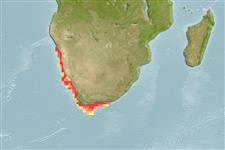Common names from other countries
Environment: milieu / climate zone / depth range / distribution range
Ecologia
; intervalo de profundidade 0 - 200 m (Ref. 4). Subtropical, preferred 18°C (Ref. 107945); 21°S - 37°S, 12°E - 26°E (Ref. 4)
Southeast Atlantic: Namibia to South Africa.
Length at first maturity / Tamanho / Peso / Idade
Maturity: Lm 6.6, range 5 - ? cm Max length : 46.0 cm BL macho/indeterminado; (Ref. 4)
It has a maximum total body length of 46 cm and a carapace length of 18 cm. Maximum depth from Ref. 113432. Fisheries: The tails of this species are exported frozen in the shell, or peeled and canned. Experimental work on culture techniques for this species are underway in South Africa. Protective measures includes a size limit (carapace length 8.5 cm), a closed season from July 1 to October 31, bag limits for sports fishermen (2 specimens per day), and the prohibition of taking ovigerous females or soft shelled specimens (Ref. 4). Occurs at depths from 0 to 46 m of coastal waters and inhabits rocky bottoms, sometimes with patches of sand and mud (Ref. 4).
Life cycle and mating behavior
Maturidade | Reprodução | Desova | Ovos | Fecundidade | Larvas
The males molt between September and December. In the females, molting occurs in April or May, after which copulation takes place. Ovigerous females are found from May to October (Ref. 4).
Holthuis, L.B. 1991. (Ref. 4)
Status na Lista Vermelha da IUCN (Ref. 130435)
Status no CITES (Ref. 108899)
Not Evaluated
Not Evaluated
Uso pelos humanos
Pescarias: espécies comerciais
FAO - pescarias: landings | FishSource | Sea Around Us
Ferramentas
Fontes da internet
Estimates based on models
Preferred temperature
(Ref.
115969): 14.6 - 19.5, mean 16.7 (based on 12 cells).
Resiliência
Baixo, tempo mínimo de duplicação da população 4,5 - 14 anos (K=0.1-0.11).
Vulnerabilidade
Moderate vulnerability (36 of 100).
